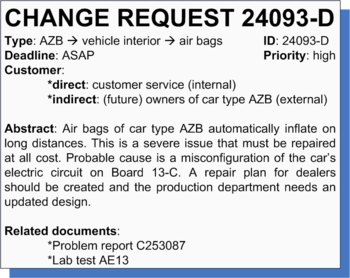Change request
This article includes a list of general references, but it lacks sufficient corresponding inline citations. (October 2014) |
A change request (aka Change Control Request, or CCR) is a document containing a call for an adjustment of a system; it is of great importance in the change management process.

Purpose and elements[]
A change request is declarative, i.e. it states what needs to be accomplished, but leaves out how the change should be carried out. Important elements of a change request are an ID, the customer (ID), the deadline (if applicable), an indication whether the change is required or optional, the change type (often chosen from a domain-specific ontology) and a change abstract, which is a piece of narrative (Keller, 2005). An example of a change request can be found in Figure 1 on the right.
Sources[]
Change requests typically originate from one of five sources:
- problem reports that identify bugs that must be fixed, which forms the most common source
- system enhancement requests from users
- events in the development of other systems
- changes in underlying structure and or standards (e.g. in software development this could be a new operating system)
- demands from senior management (Dennis, Wixom & Tegarden, 2002).
Additionally, in Project Management, change requests may also originate from an unclear understanding of the goals and the objectives of the project.[1]
Synonyms[]
Change requests have many different names, which essentially describe the same concept:
- Request For Change (RFC) by Rajlich (1999); RFC is also a common term in ITIL (Keller, 2005) and PRINCE2 (Onna & Koning, 2003).
- Engineering Change (EC) by Huang and Mak (1999);
- Engineering Change Request (ECR) at Aero (Helms, 2002);
- Engineering Change Order (ECO) by Loch and Terwiesch (1999) and Pikosz and Malmqvist (1998). Engineering Change Order is a separate step after ECR. After ECR is approved by Engineering Department then an ECO is made for making the change;
- Change Notice at Chemical (Helms, 2002);
- Action Request (AR) at ABB Robotics AB (Kajko-Mattson, 1999);
- Change Request (CR) is, among others, used by Lam (1998), Mäkäräinen (2000), Dennis, et al. (2002), Crnkovic, Asklund and Persson-Dahlqvist (2003) and at ABB Automation Products AB (Kajko-Mattsson, 1999).
- Operational Change Request (OCR).
- Enterprise Change Request (ECR).
See also[]
- Change management (engineering)
- Change control
- Change order
- Engineering Change Order
References[]
- ^ Nielsen, Dave. "How to Control Change Requests", PM Hut, November 15, 2009. Retrieved on March 2, 2010.
Further reading[]
- Crnkovic I., Asklund, U. & Persson-Dahlqvist, A. (2003). Implementing and Integrating Product Data Management and Software Configuration Management. London: Artech House.
- Dennis, A., Wixom, B.H. & Tegarden, D. (2002). System Analysis & Design: An Object-Oriented Approach with UML. Hoboken, New York: John Wiley & Sons, Inc.
- Helms, R.W. (2002). Product Data Management as enabler for Concurrent Engineering. PhD dissertation. Eindhoven: Eindhoven University of Technology press. Available online: http://alexandria.tue.nl/extra2/200211339.pdf.
- Huang, G.H. & Mak, K.L. (1999). Current practices of engineering change management in UK manufacturing industries. International Journal of Operations & Production Management, 19(1), 21–37.
- Kajko-Mattsson, M. (1999). Maintenance at ABB (II): Change Execution Processes (The State of Practice). Proceedings of the International Conference on Software Maintenance, 307–315.
- Keller, A. (2005). Automating the Change Management Process with Electronic Contracts. Proceedings of the 2005 Seventh IEEE International Conference on E-Commerce Technology Workshops, 99-108.
- Lam, W. (1998). Change Analysis and Management in a Reuse-Oriented Software Development Setting. In Pernici, B. & Thanos, C. (Eds.) Proceedings of the Tenth International Conference on Advanced Information Systems Engineering, 219–236.
- Loch, C.H. & Terwiesch, C. (1999). Accelerating the Process of Engineering Change Orders: Capacity and Congestion Effects. Journal of Product Innovation Management, 16(2), 145–159.
- Mäkäräinen, M. (2000). Software change management processes in the development of embedded software. PhD dissertation. Espoo: VTT Publications. Available online: http://www.vtt.fi/inf/pdf/publications/2000/P416.pdf.
- Onna, M. van & Koning, A. (2003). The Little Prince 2: A Practical Guide to Project Management, Pink Roccade Educational Services/Ten Hagen Stam.
- Pikosz, P. & Malmqvist, J. (1998). A comparative study of engineering change management in three Swedish engineering companies. Proceedings of the DETC98 ASME Design Engineering Technical Conference, 78–85.
- Rajlich, V. (1999). Software Change and Evolution. In Pavelka, J., Tel, G. & Bartošek, M. (Eds.), SOFSEM'99, Lecture Notes in Computer Science 1725, 189–202.
- DiDonato, P. (2001). Oakley Inc, Developing XML systems with (CRF).
- Systems engineering
- Business terms